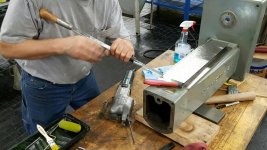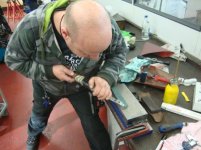Richard King
Diamond
- Joined
- Jul 12, 2005
- Location
- Cottage Grove, MN 55016
It has been long enough for me to ask my many students who have taken my class on Machine Rebuilding
"What can you share to the new rookie scrapers who come here for answers."
I have been teaching my Richard Kings 4 Rules of scraping and writing about it on here for years. In recent threads I see the readers who have never met me are following those rules in the photo's they share. I know the Techniques I teach are long known Rules in the professional rebuilding world, so I can't take credit for inventing them. I just wanted to "change and spread the correct info" before I head up to the scraping world in the sky...lol (hopefully for not at least 20+ years)
I have so many members of Practical Machinist who have now taken my class who already share on here. I ask my students in the classes to pledge to me they will pass on my knowledge I taught them in the future.
I am so proud of what I have seen in the past year when I see the young and old who used to be shy and never spoke out to the old groups who used to fool rookies giving bad advice on here and on other area's of the net. I again want to thank the management of this forum for giving me and others some leeway on what we teach to the future generations who will read the archives in the future.
Please limit your answers to things you have learned from a professional scraper. Recently I know I have upset a couple of folks who tried to share their experiences who I challenged with what they wrote about. I didn't do this to Hyjack your info, But I challenged your info as I found it to be not the professional or common sense way.
I want the once rookies to teach here. I want to observe and will add a few comments from time to time.
One thing the students will learn is sometimes you will upset a few folks, but worth it to see something once called "a lost art" to be now called a "once a Lost Art" .
The major thing I have always taught was to scrape the checkerboard pattern,."
What say You on what you learned to make your scraping improve?
"What can you share to the new rookie scrapers who come here for answers."
I have been teaching my Richard Kings 4 Rules of scraping and writing about it on here for years. In recent threads I see the readers who have never met me are following those rules in the photo's they share. I know the Techniques I teach are long known Rules in the professional rebuilding world, so I can't take credit for inventing them. I just wanted to "change and spread the correct info" before I head up to the scraping world in the sky...lol (hopefully for not at least 20+ years)
I have so many members of Practical Machinist who have now taken my class who already share on here. I ask my students in the classes to pledge to me they will pass on my knowledge I taught them in the future.
I am so proud of what I have seen in the past year when I see the young and old who used to be shy and never spoke out to the old groups who used to fool rookies giving bad advice on here and on other area's of the net. I again want to thank the management of this forum for giving me and others some leeway on what we teach to the future generations who will read the archives in the future.
Please limit your answers to things you have learned from a professional scraper. Recently I know I have upset a couple of folks who tried to share their experiences who I challenged with what they wrote about. I didn't do this to Hyjack your info, But I challenged your info as I found it to be not the professional or common sense way.
I want the once rookies to teach here. I want to observe and will add a few comments from time to time.
One thing the students will learn is sometimes you will upset a few folks, but worth it to see something once called "a lost art" to be now called a "once a Lost Art" .
The major thing I have always taught was to scrape the checkerboard pattern,."
What say You on what you learned to make your scraping improve?








 Oh yeah, very slow...
Oh yeah, very slow...